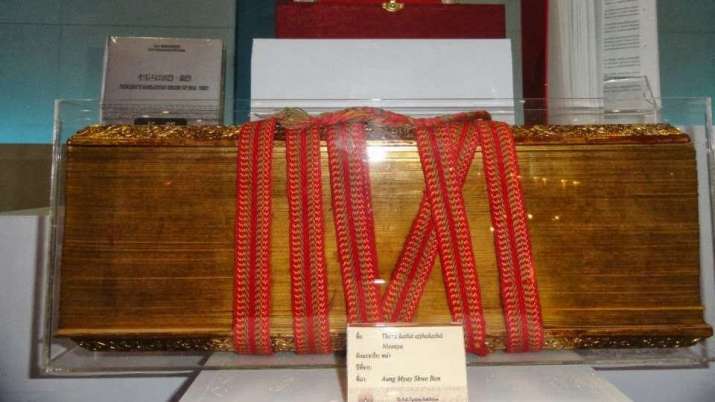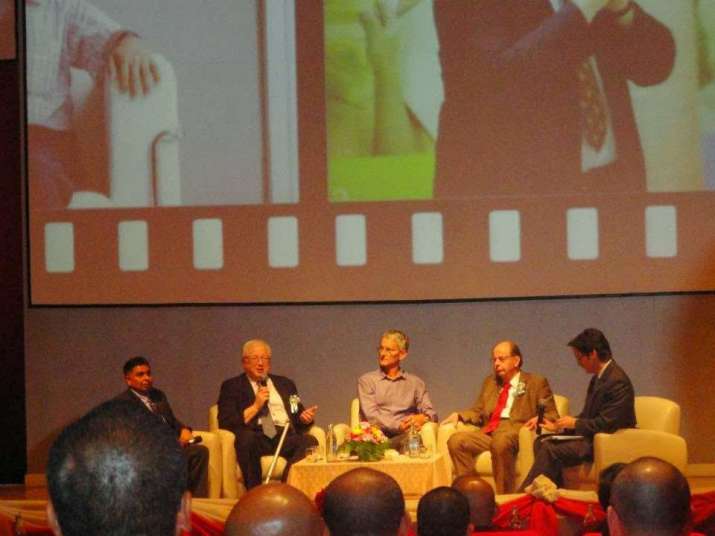
In April 2010, Wat Phra Dhammakaya (Thai: Dhammachai), a Buddhist temple in Thailand’s Pathum Thani Province, north of Bangkok, launched an ambitious initiative named the Dhammachai Tipitaka Project (DTP), with the objective of reproducing a critical edition of the Pali Canon. This edition has been made available in print and digital versions. The digital version is an online database of palm-leaf manuscripts that are freely available for supporting future research into Pali and Buddhist studies. The print edition is the Pali Canon rendered in Romanized script, and its editors hope to eventually produce editions in all of the regional scripts of the Theravada Buddhist tradition.
Work on the project is ongoing, with an editorial team of nearly 20 experts in Buddhist scriptures and the Pali language. Among them are groups working on several scripts: Burmese, Khom (Laos, Cambodia, also known as Khmer), Mon (western Thailand), Sinhalese, and Tham (Laos, northern Thailand). Their work consists mainly of reading and transliterating manuscripts through the “Online Data Entry System of Manuscripts.” An international advisory board of scholars was appointed to guide this delicate work, which includes Prof. Oskar von Hinuber and Dr. Alexander Wynne, experts in Pali and ancient manuscripts.
G. A. Somaratne, a professor of Buddhist studies at the University of Hong Kong’s Centre of Buddhist Studies, served the DTP as its founding academic co-director from 2010–14. In consultation with DTP director Ven. Phramaha Somchai Thanavuddho, Somaratne adopted a methodology of “Middle way Eclecticism” to examine the Pali texts critically, explaining:
As the word “eclecticism” conveys, DTP undertakes a methodical and controlled selection of readings from among different variants in a scientific and, therefore, legitimate way by giving considerations to both external and internal evidence. The word “middle way”, taken from Buddhist teachings, conveys that DTP, when making text-critical judgments, avoids falling into extremes. For example, for editing a Pāli Canonical text, it mistrusts those methods that count the majority of manuscripts, that count the earliest manuscripts, that present the entire collation of manuscripts with suspended judgment as of the synoptic editions, and those traditional methods that have practiced “silent corrections”, without presenting the editorial principles and evidence on the basis of which the corrections were made. (Somaratne 2014–15, 215–16)
Somaratne further noted: “I am confident that the DTP methodology is more detailed, comprehensive, up to date, transparent, accurate, and practical for a critical edition of the Pāli canonical text.” (Somaratne 2014–15, 208) He employed a large number of monks, mostly from Myanmar, Sri Lanka, and Thailand, who collected, photographed, digitized, and copied many manuscripts from different written scripts such as Burmese, Mon, Sinhalese, and Tham.
So far, more than 10,000 Pali manuscripts, Canonical and non-Canonical texts, most of which are written on palm leaf, have been photographed and stored in the digital library. When a sufficient number of manuscripts have been digitized, one is selected for the team to produce a critical edition. For any single volume, as many as five manuscripts are required from a total of 20, 30 or even 40 from each of the Burmese, Khom, Mon, Sinhala, and Tham traditions.
I reached out to DTP official Bunchird Chaowarithreonglith to enquire about the latest progress. He replied that as part of their work, the DTP has transcribed more than 200 manuscripts from the Digha Nikaya (DN), the Majjhima Nikaya, and the Samyutta Nikaya. They are now about to begin work on the Anguttara Nikaya of the Sutta Pitaka. The first volume of the DTP series was a pilot edition of the Silakkhandhavagga, the first book of the Digha Nikaya. It utilised a total of 18 manuscripts from the Burmese, Khom, Sri Lankan, and Tham manuscript traditions. Bunchird also noted that the DTP will complete the entire DN volume (I–III) by the end of this year and plans to publish online for scholar feedback. Based on the reception, the DTP will then publish a print edition. The best manuscript has been selected for identifying and correcting variants of scribal misspellings and omissions among other manuscripts.
For the Silakkhandhavagga, they selected 18 manuscripts—five from 21 Sinhalese manuscripts, five from 16 Burmese manuscripts, five from seven Khom manuscripts, and three Tham manuscripts. These 46 manuscripts date to 1679–1868.
Wynne, an assistant co-director at the DTP, prepared a preliminary report on the critical edition of the Pali Canon, noting that very few initiatives have previously been taken to preserve the manuscripts in the Theravada world. Listing the Fragile Palm-leaf Manuscripts Project, the online Digital Lao Library, and other libraries in Theravada countries that have made digital images of manuscripts available, he notes: “Within a few hundred years most manuscripts will crumble into dust, and the Theravāda tradition will lose almost all trace of its remarkable manuscripts history. Digitization, often preceded by cleaning and restoration, is therefore of the utmost importance. This work is ongoing at the Dhammakaya temple, and so far a digital library of almost 5,000 manuscripts, of both canonical and non-canonical texts, has been amassed.” (Wynne 2013, 141–42)

In February 2013, with the help of 10 universities from around the world, the DTP organized a conference and exhibition of the Pali Canon titled “Perpetuation of the Buddha’s Teachings: During Buddha’s Time to the Present Day.” Held at the Thailand Science Park Convention Center in Pathumthani, the purpose was to discuss the digital preservation of ancient manuscripts and how a database of the Tripitaka could be created to assist the continued study of Buddhism. Guests such as Prof. Richard Gombrich, Prof. Oskar von Hinüber, Prof. Rupert Gethin, and Prof. Masahiro Shimoda offered recommendations, some of which were already implemented in producing the critical edition of the Pali Canon.
Bunchird said that in the course of editing texts, there would be weekly discussions among DTP researchers. An annual seminar titled “Pali Texts and Manuscripts” will be organised based on these weekly discussions, with an accompanying publication in the form of a research series. The first volume is being prepared and due to be published by the end of this year.
For about 2,000 years, the Pali texts have been transmitted to Cambodia, Laos, Myanmar, Sri Lanka, and Thailand. However, most extant Pali texts are no older than 1,500 years. During this period, the transmission of Pali texts has been carried out through palm leaves, which are extremely perishable.
To preserve the Pali texts, many printed editions have been reproduced, some of which are also available online. Two widely available editions are by the Pali Text Society (PTS), which was founded in London in 1881. There is also the Sixth Council edition, produced in 1956, also known as the Burmese edition and available as the Vipassana Research Institute on CD and online. While the Burmese edition is based on many Burmese manuscripts, the PTS edition is based mostly on a handful of manuscripts from Sri Lanka and Myanmar. Therefore, many Buddhist scholars assert that these two editions cannot provide a standard version of the Pali Canon.
Somaratne observes, “The unavailability of manuscripts from Thailand in particular made the PTS editors miss some good readings or elements of good readings preserved by several script traditions and manuscript families in the region in making their text critical judgments. Any critical edition of a Pali Canonical text that does not use Tham, Khom, and Mon manuscripts of Southeast Asia should be incomplete, and hence, weak.” (Somaratne 2014–15, 207–8)
The project is targeted to be completed by 2027, amid hope that the world will benefit from this latest critical version of the Pali Canon, which would be a significant step forward for researchers and for Buddhist studies.
References
Somaratne, G.A. 2014–15. “Middle Way Eclecticism: The Text-Critical Method of the Dhammachai Tipiṭaka Project.” Journal of Buddhist Studies XIII. 207–39.
Wynne, Alexander. 2013. “A Preliminary Report on the Critical Edition of the Pāli Canon being prepared at Wat Phra Dhammakāya.” Thai International Journal of Buddhist Studies IV. 135–70.
Srisetthaworakul, Suchada. 2017. “Developing Database of the Pāli Canon from the Selected Palm-leaf Manuscripts: Method of Reading and Transliterating the Dīghanikāya in Khom and Tham Scripts.” Journal of Indian and Buddhist Studies 65, No. 3. 1,136–42.
See more
Pāḷi Ur-Text: Some Recent Observations by Alex Wynne (Jayarava’s Raves)
A New Critical Edition of the Pali Canon? (Dhamma Wheel)
Project History (POPDTP: The Transmission of Dhamma)












